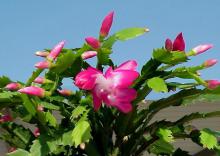Information Possibly Outdated
The information presented on this page was originally released on December 2, 2002. It may not be outdated, but please search our site for more current information. If you plan to quote or reference this information in a publication, please check with the Extension specialist or author before proceeding.
Flowering cactus creates awesome holiday displays
By Norman Winter
MSU Horticulturist
Central Mississippi Research & Extension Center
If you want a Christmas or holiday plant that will easily re-bloom every year, then the Christmas cactus is unbeatable.
The cacti in my office are living and blooming proof. Although I have had them for several years, they are abandoned for weeks on end during the spring and fall garden season. If they get water or any other light sitting in a north window, they are lucky.
Then this time of the year they reward me with their floral displays as if I were a long lost friend, or as if I had been pampering them for months. It is almost incredible. The next amazing aspect for these plants is the unbelievably low price at which they are selling right now.
The Christmas cactus is one of those plants that triggers fierce arguments over its botanical name and whether it is a Christmas cactus or a Thanksgiving cactus. I am just thankful for it whenever it blooms. The New Royal Horticultural Dictionary says it is no longer called zygocactus. Botanically speaking, most of the Christmas cactus sold are Schlumbergera x buckleyi, which is a cross between S. truncata and S. russeliana. In fact, there are more than 200 named cultivars.
These hybrids may be a little more like the S. truncata that blooms in late autumn, or they may be a little more like S. russeliana and bloom later. The bloom period is somewhat controlled by the amount of uninterrupted darkness the plant receives. You can delay blooming by giving more light. Once the plant receives 12 to 14 hours of uninterrupted darkness each day, buds will start to form.
An odd bit of trivia, whether you are a horticulturist or gardener, is that this plant is a true cactus, no thorns mind you, and it is native to the South American rain forest. In Brazil, they grow on tree trunks and limb alongside orchids and bromeliads, wherever rainwater quickly drains away. Their flowers are almost iridescent in shades of lavender, fuchsia, orange, red and white.
Despite the neglect I give mine, it is best to keep them in a bright, cool location. Keep the soil moist, but not soggy. Don't fertilize until growth begins in the spring.
Once temperatures stay above freezing, you can move the Christmas cactus outdoors for the spring and summer. Keep it in an area that is shaded, especially in the afternoon. Feed with a dilute water-soluble fertilizer every time you water.
Around the first of October next year, place it in an area where it will receive no light for about 12 hours each late afternoon and night. Buds should start to develop around the first of November and open between Thanksgiving and Christmas.
You can start new Christmas cacti by simply taking stem sections of two or three segments and sticking them in very porous, moist potting soil. I prefer sand. They will root very quickly.
One other cactus I want to call to your attention is called the Sunrise Cactus, Rhipsalidopsis gartneri. You will find this one for sale when it is blooming in late winter. What is extra special about this selection is that the blooms open in the morning and close in the evening for several weeks.
These tropical cacti are fun to grow and in my opinion the easiest holiday plant to get to re-bloom. Buy some now and start a tradition whereby your children or grandchildren see them blooming each Thanksgiving or Christmas at your home. You will be making lasting memories.




